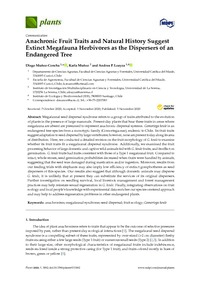Anachronic fruit traits and natural history suggest extinct megafauna herbivores as the dispersers of an endangered tree
Autor
Muñoz-Concha, Diego
Muñoz, Karla
Loayza, Andrea P.
Fecha
2020Resumen
Megafaunal seed dispersal syndrome refers to a group of traits attributed to the evolution of plants in the presence of large mammals. Present-day plants that bear these traits in areas where megafauna are absent are presumed to represent anachronic dispersal systems. Gomortega keule is an endangered tree species from a monotypic family (Gomortegaceae), endemic to Chile. Its fruit traits suggest adaptation to seed dispersal by large vertebrates; however, none are present today along its area of distribution. Here, we conducted a detailed revision on the fruit morphology of G. keule to examine whether its fruit traits fit a megafaunal dispersal syndrome. Additionally, we examined the fruit processing behavior of large domestic and captive wild animals fed with G. keule fruits, and its effect on germination. G. keule fruits had traits consistent with those of a Type 1 megafaunal fruit. Compared to intact, whole stones, seed germination probabilities decreased when fruits were handled by animals, suggesting that the seed was damaged during mastication and/or ingestion. Moreover, results from our feeding trials with elephants may also imply low efficiency of extinct gomphotheres as seed dispersers of this species. Our results also suggest that although domestic animals may disperse G. keule, it is unlikely that at present they can substitute the services of its original dispersers. Further investigation on seedling survival, local livestock management and forest management practices may help reinstate sexual regeneration in G. keule. Finally, integrating observations on fruit ecology and local people’s knowledge with experimental data enriches our species-centered approach and may help to address regeneration problems in other endangered plants.
Fuente
Plants, 9(11), 1492Link de Acceso
Click aquí para ver el documentoIdentificador DOI
doi.org/10.3390/plants9111492Colecciones
La publicación tiene asociados los siguientes ficheros de licencia:


